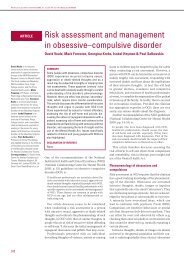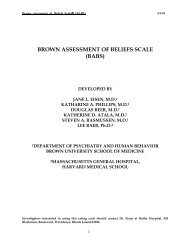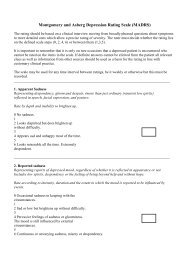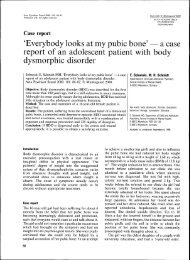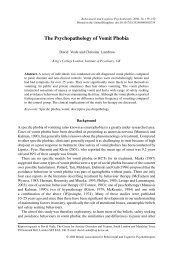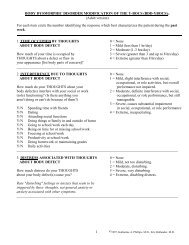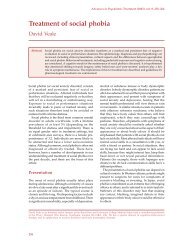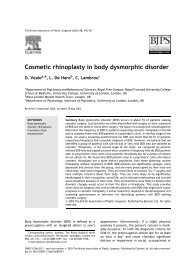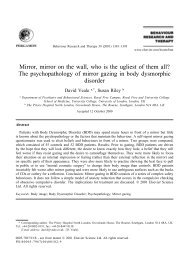Cognitive behaviour therapy for a specific phobia of vomiting
Cognitive behaviour therapy for a specific phobia of vomiting
Cognitive behaviour therapy for a specific phobia of vomiting
Create successful ePaper yourself
Turn your PDF publications into a flip-book with our unique Google optimized e-Paper software.
276 D. VealeThis article describes a cognitive <strong>behaviour</strong>al <strong>for</strong>mulation, which incorporates many <strong>of</strong>the findings from a previous survey (Veale & Lambrou, 2006), the paper by Boschen(2007), as well as advances made in the treatment <strong>of</strong> anxiety disorders over the past10 years.Treatment modelThe model used is <strong>of</strong> aversive memories <strong>of</strong> <strong>vomiting</strong> becoming associated with fear. Pastaversive experiences <strong>of</strong> oneself or others <strong>vomiting</strong> (and their cues) become fused with thepresent so that they are re-experienced as if they are about to be repeated. It is possible thatvicarious learning may also occur. Once the association is learnt, the core appraisal is <strong>of</strong> nauseaas impending vomit (Clark, 1988) and the evaluation <strong>of</strong> <strong>vomiting</strong> as one <strong>of</strong> extreme awfulnessleading to further anxiety and nausea.There are various responses to a current threat <strong>of</strong> impending vomit.(a) Experiential avoidance <strong>of</strong> thoughts and images <strong>of</strong> oneself or others <strong>vomiting</strong> andinteroceptive cues <strong>for</strong> nausea.(b) Avoidance <strong>of</strong> external threats that could lead to <strong>vomiting</strong> or nausea.(c) Hyper-vigilance <strong>for</strong> monitoring external threats (e.g. people who could be ill or an escaperoute).(d) Self-focused attention <strong>for</strong> monitoring <strong>of</strong> nausea.(e) Worry, self-reassurance and mental planning <strong>of</strong> escape routes from others <strong>vomiting</strong>.(f) An over-inflated sense <strong>of</strong> responsibility and belief in one’s ability to stop oneself from<strong>vomiting</strong>.(g) Safety-seeking <strong>behaviour</strong>s including compulsive checking and reassurance seeking.In a functional analysis, all these responses will have an unintended consequence <strong>of</strong>increasing the frequency <strong>of</strong> thoughts about <strong>vomiting</strong> and symptoms <strong>of</strong> nausea and will preventdisconfirmation <strong>of</strong> the threat <strong>of</strong> <strong>vomiting</strong>. Avoidance <strong>of</strong> people and activities related to <strong>vomiting</strong>prevents extinction and prevents disconfirmation <strong>of</strong> expectations and the ‘awfulness’ <strong>of</strong> a fearand rein<strong>for</strong>ces avoidance <strong>of</strong> nausea and cues related to <strong>vomiting</strong>. Vomiting may occur rarelybut it does not lead to a diminished fear response, perhaps because it does not occur frequentlyenough and the association with fear is very powerful.Developmental <strong>for</strong>mulationThe therapist should take a chronological history <strong>of</strong> the client’s experiences <strong>of</strong> <strong>vomiting</strong> fromthe earliest age she can recall. This should include a past history <strong>of</strong> (a) when she vomited,(b) when she experienced panic or severe anxiety and strongly believed she was going tovomit, (c) when she witnessed others <strong>vomiting</strong> or was vomited upon. The therapist shouldalso determine the age and the context in which the event occurred (e.g. an infection), and askabout how anxiety-provoking each experience was (e.g. on a scale between 0 and 10).Imagery is a powerful means <strong>of</strong> evoking emotion and may be helpful to understand theassociations or meaning attached to such experiences. If the client is willing (as this is a <strong>for</strong>m<strong>of</strong> exposure in imagination), the therapist can ask her to close her eyes and re-experience themost distressing experiences in her mind’s eye and to describe this in the first-person presenttense from a field perspective (i.e. not looking back as an observer <strong>of</strong> oneself). Do any <strong>of</strong>



